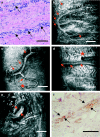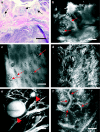Evaluation of human knee meniscus biopsies with near-infrared, reflectance confocal microscopy. A pilot study
- PMID: 16191102
- PMCID: PMC2517441
- DOI: 10.1111/j.0959-9673.2005.00439.x
Evaluation of human knee meniscus biopsies with near-infrared, reflectance confocal microscopy. A pilot study
Abstract
Knee cartilage biopsy is used to confirm the pathology in both clinical and experimental conditions and often guides diagnosis and therapeutic strategies. Current histopathological techniques are time consuming, induce tissue artefacts and often prevent further evaluation, once the tissue has been fixed. Hence, there is a potential need for a fast and nondestructive imaging technique for unfixed tissue. Near-infrared, reflectance confocal microscopy (CM) allows real-time, virtual sectioning of unstained, bulk tissue samples. This pilot study evaluates the use of CM in the assessment of meniscus histopathology in a series of 26 freshly-excised human meniscus samples compared to standard light microscopy of stained sections. CM images of the meniscus show cell and matrix detail, depicting morphologic features of collagen and elastic fibres, vessels and nerve endings. In addition, crystal deposits of gout and pseudogout are also demonstrable. Thus, CM is a novel imaging technique that could enable the pathologist to make a rapid microscopic evaluation of cartilage in a fresh and unfixed fashion.
Figures








Similar articles
-
Evaluation of hepatic histology by near-infrared confocal microscopy: a pilot study.Hum Pathol. 2002 Oct;33(10):975-82. doi: 10.1053/hupa.2002.127445. Hum Pathol. 2002. PMID: 12395369
-
Virtual biopsy of the joint tissues using near-infrared, reflectance confocal microscopy. A pilot study.Microsc Res Tech. 2006 Oct;69(10):794-8. doi: 10.1002/jemt.20348. Microsc Res Tech. 2006. PMID: 16758475
-
[Needle biopsy in gout and pseudogout (author's transl)].Beitr Pathol. 1976 Apr;157(2):161-82. Beitr Pathol. 1976. PMID: 179523 German.
-
Sonography of the knee: intra-articular pathology.J Clin Ultrasound. 2004 Nov-Dec;32(9):481-90. doi: 10.1002/jcu.20069. J Clin Ultrasound. 2004. PMID: 15558615 Review.
-
Pathology of the meniscus.Clin Orthop Relat Res. 1990 Mar;(252):32-40. Clin Orthop Relat Res. 1990. PMID: 2406071 Review.
Cited by
-
Maturation State and Matrix Microstructure Regulate Interstitial Cell Migration in Dense Connective Tissues.Sci Rep. 2018 Feb 19;8(1):3295. doi: 10.1038/s41598-018-21212-4. Sci Rep. 2018. PMID: 29459687 Free PMC article.
-
In Situ Loading and Time-Resolved Synchrotron-Based Phase Contrast Tomography for the Mechanical Investigation of Connective Knee Tissues: A Proof-of-Concept Study.Adv Sci (Weinh). 2024 Jun;11(21):e2308811. doi: 10.1002/advs.202308811. Epub 2024 Mar 23. Adv Sci (Weinh). 2024. PMID: 38520713 Free PMC article.
-
Quantitative three-dimensional collagen orientation analysis of human meniscus posterior horn in health and osteoarthritis using micro-computed tomography.Osteoarthritis Cartilage. 2021 May;29(5):762-772. doi: 10.1016/j.joca.2021.01.009. Epub 2021 Feb 13. Osteoarthritis Cartilage. 2021. PMID: 33588085 Free PMC article.
-
High angular resolution diffusion imaging (HARDI) of porcine menisci: a comparison of diffusion tensor imaging and generalized q-sampling imaging.Quant Imaging Med Surg. 2024 Apr 3;14(4):2738-2746. doi: 10.21037/qims-23-1355. Epub 2024 Mar 20. Quant Imaging Med Surg. 2024. PMID: 38617143 Free PMC article.
-
The anatomical pathology of gout: a systematic literature review.BMC Musculoskelet Disord. 2019 Apr 1;20(1):140. doi: 10.1186/s12891-019-2519-y. BMC Musculoskelet Disord. 2019. PMID: 30935368 Free PMC article.
References
-
- Arnoczky SP, Warren RF. Microvasculature of the human meniscus. Am J Sports Med. 1982;10:90–95. - PubMed
-
- Bullough PG, Munuera L, Murphy J, Weinstein AM. The strength of the menisci of the knee as it relates to their fine structure. J Bone Joint Surg. 1970;3:564–570. - PubMed
-
- Campo-Ruiz V, Ochoa ER, Lauwers GY, González S. Human liver biopsy studied with near-infrared confocal microscopy. A pilot study. Hum Pathol. 2002;33:975–982. - PubMed
-
- Danzig L, Resnick D, Gonsalves M, Akeson WH. Blood supply to the normal and abnormal menisci of the human knee. Clin Orthop. 1983;172:271–276. - PubMed
Publication types
MeSH terms
LinkOut - more resources
Full Text Sources
Other Literature Sources
Medical

